Südsudan |
|
|
|
| Übersicht – Contents: | |
Südsudan |
|
|
|
| Übersicht – Contents: | |
Flaggen – Flags: |
|
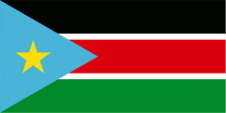 |
seit/since 2005, offiziell – official, Nationalflagge – national flag, Seitenverhältnis – ratio = 1:2, Quelle/Source, nach/by: Wikipedia (EN) |
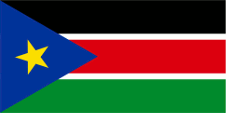 |
Variante in der Praxis – variant in practice, Nationalflagge – national flag, Seitenverhältnis – ratio = 1:2, Quelle/Source, nach/by: Wikipedia (EN)   |
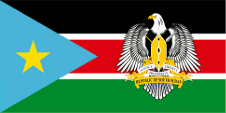 |
Flagge des Präsidenten – flag of the President, Seitenverhältnis – ratio = 1:2, Quelle/Source, nach/by: Wikipedia (EN) |
historische Flagge – historical Flag: |
|
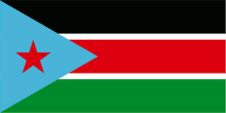 |
Flagge der SPLM – flag of the SPLM, Seitenverhältnis – ratio = 1:2, Quelle/Source, nach/by: Wikipedia (EN) |
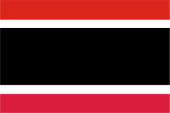 |
1967–1969, Flagge der provisorischen Regierung des Südsudan – flag of the provisional government of South Sudan, Seitenverhältnis – ratio 2:3, Quelle/Source, nach/by: World Statesmen |
| Die Flagge des Südsudan wurde am 09.07.2005 angenommen und zeigt drei horizontale Streifen in Schwarz, Rot und Grün mit schmalen weißen Trennstreifen und ein rechtwinkliges himmelblaues Dreieck mit einem gelben fünfzackigen Stern am Mast. Die Bedeutung der Farben der Flagge ist durch die südsudanesische Regierung festlegt: Schwarz steht für das südsudanesische Volk. Rot steht für das Blut, das für die Unabhängigkeit des Landes vergossen wurde. Grün steht für die Landwirtschaft, den natürlichen Reichtum, das Land und den Fortschritt des Landes. Weiß steht für den Frieden. Blau steht für das Wasser des Nils, eine Quelle des Lebens. Gelb steht für Einheit des Landes und für Hoffnung und Entschlossenheit. Die Farben der Flagge scheinen definiert zu sein, jedoch ließ sich nichts zur rechtlichen Gründlage finden, keine Gesetz und keine Verordnung. Dabei werden die Farben unter anderem im HEX-Farbraum für RBG definiert: Himmelblau = #45B4DB, Gelb = #FCDE02, Rot = #DB0A13 und Grün = #018A2C. Das würde folgenden Farben im Pantone-Farbraum entsprechen: Himmelblau = pt 2985 c, Gelb = Hexachrome Yellow, Rot = pt 1788 c und Grün = pt 355 c. Das Design der Flagge konnte sich bisher wenig durchsetzen, international wird anstelle des Himmelblau meist Dunkelblau verwendet, im Land steht der Stern mal gerade und mal schräg. Vorbild der Flagge war die Flagge der Sudan People's Liberation Movement (SPLM), die als Vorbild ihrer Flagge die Flagge von Kenia angibt. In der ersten Phase des Bürgerkriegs (1955–1972) war eine andere Flagge populär. Diese zeigte fünf horizontale Streifen in Rot, Weiß, Schwarz, Weiß und Rot im Verhältnis 3:1:8:1:3. Diese wurde von 1967 bis 1969 von der provisorischen Regierung des Südsudan verwendet. |
The flag of South Sudan
was adopted on 9th of July in 2005 and features three horizontal stripes of
black, red and green with narrow white dividing stripes and a isosceles sky
blue triangle with a yellow five-pointed star on the mast. The meaning of the colours of the flag is determined by the South Sudanese government: Black represents the South Sudanese people. Red represents the blood that was shed for the country's independence. Green represents agriculture, natural wealth, the land and the country's progress. White represents peace. Blue represents the water of the Nile, a source of life. Yellow represents unity of the country and hope and determination. The colours of the flag seem to be defined, but nothing on the legal basis could be found, no law and no regulation. The colours are defined, among others, in the HEX color space for RBG: sky blue = #45B4DB, yellow = #FCDE02, red = #DB0A13 and green = #018A2C. This would correspond to the following colors in the Pantone color space: Sky Blue = pt 2985 c, Yellow = Hexachrome Yellow, Red = pt 1788 c and Green = pt 355 c. The design of the flag has so far had little success; internationally, dark blue is usually used instead of sky blue, and in the country the star is sometimes straight and sometimes diagonal. The model for the flag was the flag of the Sudan People's Liberation Movement (SPLM), which cites the flag of Kenya as the model for its flag. During the first phase of the Civil War (1955–1972), a different flag was popular. This showed five horizontal stripes in red, white, black, white and red in a ratio of 3:1:8:1:3. That was used by the provisional government of South Sudan from 1967 to 1969. |
| Quelle/Source: Wikipedia (EN), World Statesmen, Volker Preuß | |
Wappen – Coat of Arms: |
|
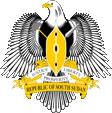 |
seit/since 2011, Wappen von Südsudan – coat of arms of South Sudan, Quelle/Source: Unknown, vectorisation by Nanin7, Public domain, via Wikimedia Commons |
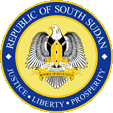 |
seit/since 2011, Siegel von Südsudan – seal of South Sudan, Quelle/Source: Unknown, vectorisation by Nanin7, Public domain, via Wikimedia Commons |
| Das Wappen des Südsudan zeigt einen afrikanischen Fischadler, dessen Brust mit einem Eingeborenenschild bedeckt ist. Dahinter, über Kreuz, eine Schaufel und ein Speer. Spruchbänder in Gold und Silber zeigen den Namen des Landes und das Landesmotto: "Justice, Liberty, Prosperity" → "Gerechtigkeit, Freiheit, Wohlstand". Der Adler steht für Stärke, Widerstandsfähigkeit, Vision und Majestät. |
The coat of arms of South
Sudan shows an African fish eagle with its chest covered with a native
shield. Behind, crossed, a shovel and a spear. Banners in gold and silver
show the name of the country and the country's motto: "Justice, Liberty,
Prosperity". The eagle represents strength, resilience, vision and majesty. |
| Quelle/Source: Wikipedia (EN) | |
Flugzeugkokarde – aircraft roundel: |
|
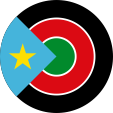 |
Flugzeugkokarde – aircraft roundel Quelle/Source, nach/by Wikipedia (EN) |
Landkarte – Map: |
Lage – Position: |
Landkarte des Landes – Map of the Country: |
|
interaktive Landkarte des Sudan – interactive Map of the Sudan 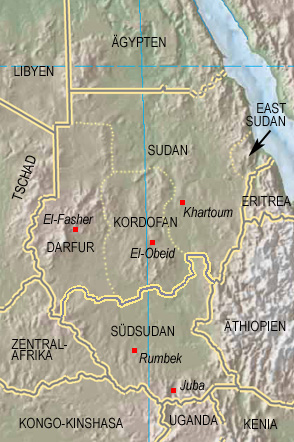 Quelle/Source: Freeware, University of Texas Libraries, modyfied by: Volker Preuß |
|
|
| Zahlen und Fakten – Numbers and Facts: | |
|
|
|
|
|
|
|
|
|
|
|
|
|
|
|
|
|
|
|
ca. 1500 – 1700 · Reich der Fundsch im südlichen Sudan, der Norden
wird von den ägyptischen Mameluken abhängig 1863–1875 · Ismail Pasha von Ägypten erobert teilweise den Südsudan und Darfur (1874) 1875–1881 · die Ägypter versuchen den Sklavenhandel zu unterbinden 1881–1898 · antiägyptisch-klerikaler Mahdiaufstand unter der Führung des Mohammed Achmed, genannt Mahdi, Bildung des Mahdireiches 1882 · Großbritannien besetzt Ägypten 1885 · Tod des Mahdi, Nachfolger wird Chalifa Abdullahi 1888–1889 · das Mahdireich attackiert Äthiopien und erobert den Südsudan 1898 · Schlacht von Omdurman, Lord Kitchener vernichtet das Mahdireich 1898 · Schlacht von Faschoda, Lord Kitchener schlägt in den Südsudan eingedrungene Franzosen zurück 1899 · der Sudan wird offiziell von Ägypten und Großbritannien gemeinsam verwaltet (Anglo-Ägyptischer Sudan) 1924 · britische Versuche den Norden und Süden des Sudan getrennt zu verwalten 1955 · der christliche und animistische Südsudan befürchtet in einem unabhängigen Sudan eine nördliche islamische Dominanz und beginnt den zunächst 17 Jahre andauernden Bürgerkrieg 01.01.1956 · Ägypten und Großbritannien gewähren dem Sudan Unabhängigkeit, Republik Sudan 1972 · Abkommen von Addis-Abeba zwischen der Regierung des Sudan und der südsudanesischen Befreiungsfront, vorläufiges Ende des Bürgerkriegs im Süden, Gewährung von Autonomie für den Südsudan 1983 · der Südsudan wird in drei separate Regionen aufgeteilt, Einführung des islamischen Rechts, der Bürgerkrieg im Süden bricht erneut aus 1984 · Verkündung des Ausnahmezustands 1992 · Offensive gegen den Südsudan 1994 · Offensive des Südsudan gegen Regierungstruppen 1996 · Isolierung des Südsudan 1997 · erfolgreiche Offensive der südsudanesischen SPLA (Sudanesische Volksbefreiungsarmee) 12.12.1999 · Verkündung des Ausnahmezustands, Auflösung des Parlaments 2005 · Juba – die Haupstadt des Südsudan – wird von Truppen des Sudan eingenommen, die provisorische Regierung verlegt nach Rumbek 2005 · Friedensabkommen, Ende der Kämpfe, Autonomie für Südsudan 2006 · Juba wird wieder Haupstadt des Südsudan 2008 · erneut Kämpfe zwischen Sudan und Südsudan 09.01.2011 · Beginn einer mehrtägigen Volksabstimmung zur Unabhängigkeit im Südsudan 09.07.2011 · der Südsudan erklärt seine Unabhängigkeit 2013–2018 · Bürgerkrieg (hauptsächlich zwischen Dinka und Nuer) |
|
ca. 1500 – 1700 · Empire of the Fundsh in the southern Sudan, the
north becomes dependent from the egypt Mameluks 1863–1875 · Ismail Pasha of Egypt conquers partially the southern Sudan and Darfur (1874) 1875–1881 · the Egyptians try to stop the slave trading 1881–1898 · anti-egyptian-clerical Mahdi revolt under the leadership of Mohammed Achmed, named Mahdi, formation of the Mahdi Empire 1882 · United Kingdom occupys Egypt 1885 · death of the Mahdi, successor is Chalifa Abdullahi 1888–1889 · the Mahdi Empire attacks Ethiopia and conquers the southern Sudan 1898 · Battle of Omdurman, Lord Kitchener destroys the Mahdi Empire 1898 · Battle of Faschoda, Lord Kitchener strikes in southern Sudan invaded Frenchmen 1899 · Sudan is officially administered by Egypt and United Kingdom (Anglo-Egyptian Sudan) 1924 · British attempts to administer separately the north and the south of Sudan 1955 · the christian and animist South Sudan fears a northern and islamic dominance within an independent Sudan and starts the first of all for 17 years enduring civil war 1st of January 1956 · Egypt and United Kingdom grant the Sudan independence, Republic of Sudan 1972 · treaty of Addis-Abeba between the government of Sudan and the South Sudanese Liberation Front, temporary end of the civil war in the south, granting of autonomy for the South Sudan 1983 · South Sudan becomes divided into three separate regions, introduction of the islamic law, the civil war in the south breaks out again 1984 · proclaim of the state of emergency 1992 · offensive against South Sudan 1994 · offensive of South against governmental troops 1996 · isolation of South Sudan 1997 · successful offensive of the south sudanese SPLA (Sudanese People's Liberation Army) 12th of December 1999 · proclaim of the state of emergency, dissolution of the parliament 2005 · Juba – capital of South Sudan – becomes conquered by troops od Sudan, the provisional government moves to Rumbek 2005 · peace agreement, end the fighting, autonomy for South Sudan 2006 · Juba is capital of South Sudan again 2008 · one more fights between Sudan and South Sudan 9th of January in 2011 · beginning of a multi-day referendum for independence in South Sudan 9th of July in 2011 · South Sudan declares its independence 2013–2018 · civil war (mainly between Dinka and Nuer) |
| Quelle/Source: Atlas zur Geschichte, World Statesmen, Wikipedia (EN), Volker Preuß |
| Die Christen und Animisten des Südsudan sind in einem der brutalsten und langwierigsten Kämpfe um nationale Unahängigkeit in Afrika mit dem islamischen Norden verwickelt. | The Christian and animist people of southern Sudan are engaged in one of Africa's fiercest and most protracted struggles for national independence with the Islamic north. |
| Der Name "Südsudan" ist ein Kunstbegriff, der sich wie ein einigendes Band um etwa dreißig verschiedene Ethnien im Süden des Sudan bindet. Jede Ethnie hat ihre eigene Miliz und eine eigene Regierung. Die stärkste Rebellengruppe ist jedoch die SPLA (Sudanesische Volksbefreiungsarmee) mit etwa 25 000 Mann, die als Regierungstruppe des Südsudan auftritt. | The name
"South Sudan" is a factitious term, which binds like a unifying bound around
ca. thirty various tribes in the south of Sudan. Every tribe has its own
militia and an own government. But the strongest rebel group is the SPLA
(Sudanese People's Liberation Army) with perhaps 25 000 men which appears as
governmental troops of the South Sudan. |
| Der Name des Sudan leitet sich von der arabischen Bezeichnung "Bilad es-Sudan" ab. Das heißt "Land der Schwarzen" und bezeichnet eigentlich die ganze Region zwischen Sahara und dem afrikanischen Regenwald von West- bis Ostafrika. In der Antike und im Mittelalter hieß das Land "Nubien", benannt nach den Nubiern, einem afrikanischen Stamm der im Norden des Sudan am Nil lebt. | The name of Sudan is derived from the Arabian denomination "Bilad es-Sudan". That means "Land of the Black" and describes actually the whole region between Sahara and the African rain forest from western to eastern Africa. In antiquity and in the middle ages the land was called "Nubia", named by the Nubians, an African tribe which lives in the north of Sudan on Nile River. |
| Quelle/Source: Handbuch der geographischen Namen, Volker Preuß | |